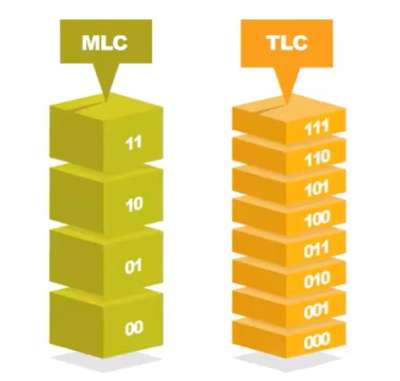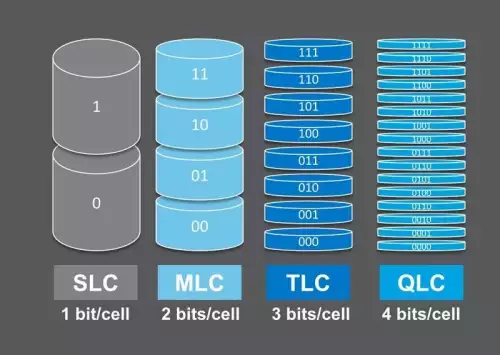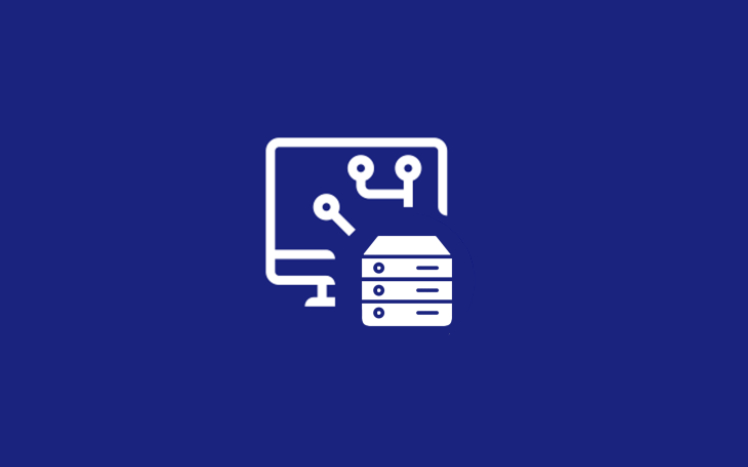MLC vs. TLC Flash: Unraveling the Differences and Best Choice

Multi-Level Cell (MLC) and Triple-Level Cell (TLC) are NAND flash memory technologies that have revolutionized storage devices, especially Solid State Drives (SSDs).
Despite significant price reductions and enhanced manufacturing efficiency, flash storage remains more costly than hard disks of equivalent capacity. Moreover, flash memory has a finite lifespan, limiting the number of write cycles, typically measured in P/E cycles. However, engineers have addressed this issue by increasing the data capacity of individual cells in NAND, enabling greater storage capacity in SSDs.
MLC and TLC offer higher storage capacities, improved performance, and cost-effective solutions across various applications. Understanding the distinctions between these two NAND technologies is crucial in determining the most suitable technology for specific requirements.
Jump To...
What does NAND Flash Storage refer to?

NAND flash storage is a non-volatile technology extensively employed in diverse devices. Unlike volatile memory, NAND retains data even when power is turned off, rendering it well-suited for internal, external, and portable devices that require data persistence. Devices like USB drives, Solid State Drives (SSDs), and SD cards leverage NAND flash technology, furnishing abundant storage for mobile phones, digital cameras, and various other applications.
MLC SSD
MLC NAND technology stores multiple bits of data per memory cell, typically 2 bits, utilizing voltage levels to represent different data states, thereby enabling increased storage density. The benefits of MLC include:
1. Enhanced storage capacity: MLC facilitates larger storage capacities by storing multiple bits per cell.
2. Improved performance: MLC offers faster read and write speeds, enhancing overall device performance.
3. Better endurance: MLC SSDs exhibit improved endurance, particularly for write-intensive workloads, contributing to their longevity and reliability.
TLC SSD
TLC NAND technology furthers storage density by storing three bits per memory cell. This higher bit also affects certain aspects of TLC, including:
It is cost-effective with lower manufacturing expenses.
It provides higher storage capacities at an affordable price.
TLC has slightly lower endurance than MLC, but recent advancements have addressed this.
Top Utilization Scenarios for TLC and MLC NAND Flash Memory
Triple-Level Cell (TLC)
- Consumer-level SSDs for everyday computing tasks.
- USB flash drives for cost-effective data storage and transfer.
- Memory cards for digital cameras and smartphones.
- Cloud storage services emphasizing cost-efficient data storage.
Multi-Level Cell (MLC)
- Enterprise-class SSDs for high-performance computing tasks.
- Industrial and automotive sectors necessitating reliability and durability.
- High-performance computing tasks for scientific research and data analysis.
- Content creation software including editing and graphic design.
Commonalities between MLC and TLC SSDs
MLC and TLC, two frequently employed Solid State Drive (SSD) technologies, exhibit several notable similarities:
Memory Cell Structure: Both utilize a comparable memory cell structure, wherein data is stored by trapping electrons in a floating gate within a transistor.
Increased Storage Density: They offer higher storage densities compared to older technologies, enabling more data to be stored in a smaller physical space.
Energy Efficiency: MLC and TLC SSDs demonstrate lower power consumption than traditional hard drives, rendering them energy-efficient options for portable devices.
Advanced Error Correction: Both necessitate advanced error correction techniques to ensure data reliability and maintain data integrity.
MLC V/S TLC SSD drive
Performance: MLC SSDs generally offer superior performance compared to TLC. MLC’s lower bit density allows for faster read and write speeds than TLC drives, making it more suitable for high-speed data access applications like gaming or professional use.
Endurance: MLC typically exhibits higher endurance compared to TLC. MLC memory cells can endure more program-erase cycles before experiencing performance degradation, making them better suited for write-intensive applications like servers or data centers.
Cost and Capacity: TLC is more cost-effective and provides higher storage capacities than MLC. TLC stores three bits per cell, while MLC stores two. The higher bit density of TLC allows for more data storage in each cell, resulting in larger capacities at a lower cost. TLC is commonly used in consumer-grade SSDs, where low cost and high capacity are critical factors.
Reliability: MLC offers better reliability due to its lower bit density. The lower number of data bits stored in each cell reduces the chance of errors occurring during read and write operations, making MLC more suitable for applications that require critical data storage, such as enterprise-level systems.
Use Cases: MLC is often preferred for professional and high-performance applications like database management or virtualization, where superior performance and reliability are crucial. Conversely, TLC is well-suited for consumer applications such as laptops, gaming consoles, and personal computing, where cost and capacity are more important considerations.
Longevity: MLC typically offers a longer lifespan than TLC due to its lower bit density and higher endurance. MLC-based SSDs can sustain more program-erase cycles before wearing out, making them suitable for applications where long-term reliability and longevity are paramount.
Closing Thoughts
In conclusion, MLC and TLC are two influential NAND flash memory technologies that have significantly impacted the storage industry. MLC stores 2 bits per memory cell, while TLC stores 3 bits per cell, enabling higher storage densities compared to older technologies.
The choice between MLC and TLC depends on specific requirements and priorities. MLC offers superior performance, endurance, and reliability, making it suitable for professional-grade applications like data centers and video editing. Conversely, TLC provides a more cost-effective solution with larger storage capacities, catering to consumer-grade devices such as laptops, gaming consoles, and personal computing.
Ultimately, the decision between MLC and TLC depends on factors like performance needs, budget constraints, and required storage capacities. It’s essential to carefully evaluate these factors and consider the specific demands and characteristics of the intended application to determine whether MLC or TLC is the better choice.
Frequently Asked Questions
MLC represents Multi-Level Cell, whereas TLC signifies Triple-Level Cell. These are NAND flash memory technologies utilized in storage devices such as Solid State Drives (SSDs).
The primary distinction lies in the number of bits they store per memory cell. MLC stores 2 bits, whereas TLC stores 3 bits per cell, leading to varying performance, cost characteristics, and durability.
The selection depends on particular needs. MLC delivers superior performance and endurance at a higher cost, whereas TLC offers greater capacity and lower cost, albeit with slightly reduced performance and endurance.
MLC provides quicker read and write speeds, improved endurance, and greater reliability. It is ideal for professional and high-performance applications demanding speed and robustness.
TLC offers higher storage capacities at a more economical price point, making it well-suited for consumer-grade applications such as laptops, gaming consoles, and personal computing.
TLC is typically more cost-effective because of its higher bit density, enabling larger storage capacities at a lower manufacturing cost.
Selecting the appropriate technology depends on the specific requirements of the application. MLC and TLC offer different performance and endurance characteristics, so choosing the right one based on the intended use is crucial.
Indeed, both MLC and TLC can offer reliable performance. However, MLC typically provides better reliability due to its lower bit density, which reduces the likelihood of errors during data operations.
Absolutely, MLC is indeed well-suited for professional and high-performance applications such as video editing, database management, or virtualization, where factors like speed, endurance, and reliability are paramount.
Indeed, TLC is commonly utilized in USB flash drives and consumer applications, prioritizing cost and storage capacity over extreme performance and endurance.




